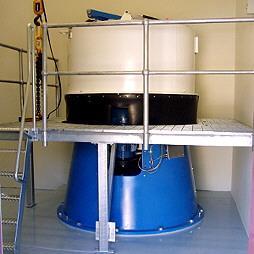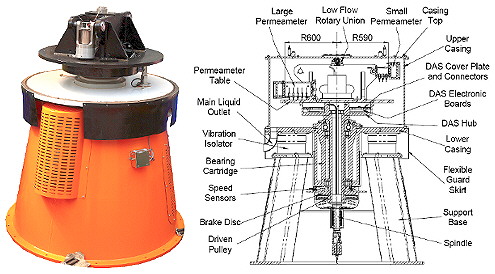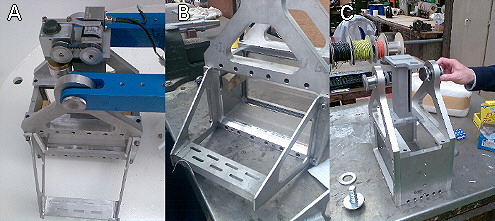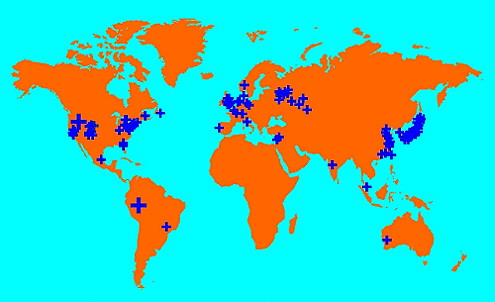Posted 14 August 2013

The centrifuge permeameter.
A state-of-the-science, world class centrifuge permeameter facility has been approved as part of the NCGRT Program 1B. Funded by the ARC and NWC, the facility will be commissioned in late 2010. A contract was signed between UNSW and Broadbent Centrifuges in March 2010 to construct, test and commission the new centrifuge facility at the UNSW Water Research Laboratory.
The NCGRT centrifuge permeability facility would be unique in the following aspects.
The NCGRT centrifuge will be the only core permeameter centrifuge in the world capable of direct testing of minimally disturbed drill core of 100 mm diameter (Figure 1).
This type of drill core can be retrieved without rotation, distortion or compression of geological material using standard coring equipment. Other permeameters around the world are designed to test 33 diameter mm core or 151 mm diameter core. The 100 mm core is considered to be the optimum diameter to achieve representative flow in a relatively large sample, while minimising drilling costs and transport/handling issues of geological material. It will be possible to sample from the core while the centrifuge is in operation. This 'in-flight' operational capability is a major benefit for the collection of representative samples.

Figure 1. NCGRT Centrifuge - Core Permeameter Modeling. A) Base unit with permeameters, B) Small (R= 0.47 m, ~0.5 L) and large permeameter schematic (R = 0.3 m, ~5 L). Minimally disturbed core of 100-150 mm diameter is fitted in both types of permeameters that operate in duplicate (ie. one type of permeameter at a time).
The NCGRT centrifuge will be capable of higher g-levels than typical geotechnical centrifuges (ie. 300 gmax at 0.7 m radius as compared with 80 gmax typical). The high g-level is essential to drive fluid through low permeability aquitard material that is to be tested. Calculations show that the design centrifuge would be capable of testing material with hydraulic conductivity of 10-12 m/s, which is four orders of magnitude smaller than material that is considered by the EPA to be of low permeability.
The modular centrifuge base of the NCGRT facility would be the only one in the world operating with both core permeameter and tank testing systems. The swing-tank rotating on a small beam would enable testing of heterogeneity of groundwater systems (see Figure 2). The tank could be set up to study layered groundwater systems, heterogeneous sediments, discontinuous aquitards, and study the potential impact of fault lines and leaky bores at a suitable physical scale. A 0.3 m thick groundwater model at a scale of 300g would represent a 90 m thick groundwater system in the real world. The ability to speed up time using this approach provides an unparalleled opportunity for innovative research.

Figure 2. NCGRT Centrifuge - Tank Modelling of Hetereogeneity - A) Small beam (R = 0.65m attaches to same centrifuge base as in Fig. 1. B-C) Swing tank and PIV Camera Mount (170 mm circumference, 180 mm radius, 300 mm high, ~10 L capacity).
The novelty of a 'time-machine' for scientific studies can generate both publicity and internationally relevant science. A popular article on 'time-machine' research was recently posted on this web site. Research opportunities arising from a centrifuge permeameter provide an outstanding example not only of a state-of-the-science piece of equipment, but leading edge research focused on fluid flow processes over spatial and time scales that cannot be readily studied.
Scientific advances occur typically at the interfaces of disciplines where gaps in knowledge are bridged. Centrifugation is an accepted technique in geotechnical engineering, yet remains largely unexplored in hydrogeology. Whilst geotechnical applications of centrifuge modelling reached a degree of maturity with the publication of the first text book in the mid-1990's (Taylor, 1995), the power and utility of centrifugation is not recognised or appreciated within the water resources and hydrogeological profession.
It is also recognised that there is a critical gap in knowledge between soil science and hydrogeology. Soil studies of deep drainage and infiltration focus on the unsaturated zone to a maximum depth of 6 m, while hydrogeological studies focus on the saturated zone where the first high yield aquifer may occur at 20-30 m depth. Centrifugation could study geological media in saturated, unsaturated and variable saturation state and help bridge these gaps.
Centrifugation can directly address questions of sub-surface flow at scales that are not otherwise possible:
While there are clearly applications of centrifuge modelling for industry, there will likely be an extensive period of promotion and demonstration that is required for industry to become aware of the prospects and powerful utility of centrifuge modelling. Examples of strategic industry involvement is outlined below:

Figure 3: Worldwide Distribution of Geotechnical Centrifuges (Courtesy: CCORE, Canada, undated). Note that there is currently only one other centrifuge permeameter testing facility of the type to be commissioned by NCGRT (University of Texas, USA).
Acworth, I. and Timms, W (2009), Investigation of deep drainage through smectite-dominated clays at Breeza on the Liverpool Plains of New South Wales. Australian Journal of Earth Sciences 56 (71-86).
Conca, J.L. and J. Wright. (1998). The UFA method for rapid, direct measurements of unsaturated transport properties in soil, sediment and rock, Australian Journal of Soil Research 36, 1-25.
McCartney, J.S. (2007). Determination of the Hydraulic Characteristics of Unsaturated Soils using a Centrifuge Permeameter. PhD Thesis, The University of Texas at Austin, Faculty of the Graduate School.
Nimmo, J.R., and K.A. Mello. (1991). Centrifugal techniques for measuring saturated hydraulic conductivity. Water Resources Research 27, no. 6: 1263-1269.
Taylor, R.N. (1995). Geotechnical centrifuge technology. Taylor and Francis, London.
Simunek, J and Nimmo, J. (2005). Estimating soil hydraulic parameters from transient flow experiments in a centrifuge using parameter optimization technique. Water Resources Research 41(4).
Timms, W, Hendry, J., Muise J, and Kerrich, R. (2009). Coupling Centrifuge Modeling and Laser Ablation ICP-MS to determine contaminant retardation in clays. Environmental Science and Technology. 2009, 43, 1153-1159
Timms, W.A., Hendry, M.J. (2008). Long term reactive solute transport in an aquitard using a centrifuge model. Ground Water 46(4): 616-628
Timms, W.A., and M.J. Hendry. (2006). Quantifying the impact of cation exchange on long-term solute transport in a clay-rich aquitard. Journal of Hydrology 332: 110-122,
Timms, W.A. and Hendry, M.J., (2003). Application of centrifuge modelling to assess long term brine migration in thick clay till, Saskatchewan, Canada., Australian Institute of Mining and Metallurgy Conference "Water in Mining", Brisbane, October 13-15, 2003., pp. 363-372.
Timms, W. and Hendry (2004). Quantifying the impact of ion exchange on long-term solute transport in clay aquitards using centrifugation and geochemical modelling. Geological Society of America, 7-10th November 2004, Denver, USA.
Timms, W., J. Hendry. (2003). Verifying accelerated physical modeling of reactive solute transport: the long term development of pore water solute profiles in a thick clay till. European Geophysical Union Convention, Nice, France, April 2003.
Wright, M. D., P. Dillon, P. Pavelic, P. Peter, and A. Nefiodovas. (2002). Measurement of 3-D hydraulic conductivity in aquifer cores at in situ effective stresses. Ground Water 40, no. 5, 509-517
Groundwater level monitoring data recovered at the end of 2019 from Mystery Road at Breeza on the Liverpool Plains reveals a direct connection between the Gunnedah Formation unconsolidated sands and gravels and the underlying Permian coal measures. The connection is provided by the old deep channel of the Mooki River that cuts down into the coal measures. This is a crucial piece of evidence to be incorporated into groundwater models.
What are the effects of fire on water underground? Let’s think about what happens on the surface, and translate that to what is likely to happen to the subsurface.

The effects of tidal forces on groundwater might be less apparent to us than their effects on the ocean, but they’re just as important.

Dr Oliver Knox has brought together information from some of the industry’s researchers conducting work oncotton-producing soils.
Groundwater research at ANSTO has provided crucial information to support the management of finite groundwater resources appropriately and sustainably—answering questions about groundwater recharge, groundwater age and dynamics, the interaction between surface water and groundwater and salinisation.